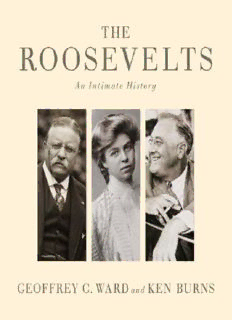
The Roosevelts: An Intimate History PDF
Preview The Roosevelts: An Intimate History
Former president Theodore Roosevelt waves to the New York crowds gathered to greet him on his triumphant return from Africa and Europe, June 8, 1910. Franklin and Eleanor Roosevelt smile at the camera in front of the smokestack at the right. This and two other photographs made from the same vantage point the same day are the only known images that include all three of the most celebrated Roosevelts. THIS IS A BORZOI BOOK PUBLISHED BY ALFRED A. KNOPF Copyright © 2014 by Geoffrey C. Ward and Ken Burns All rights reserved. Published in the United States by Alfred A. Knopf, a division of Random House LLC, New York, and in Canada by Random House of Canada Limited, Toronto, Penguin Random House companies. www.aaknopf.com Knopf, Borzoi Books, and the colophon are registered trademarks of Random House LLC. ISBN: 978-0-307-70023-0 (hardcover) ISBN: 978-0-38535306-9 (eBook) Cover photographs (left): Theodore Roosevelt Collection, Houghton Library, Harvard University; (center and right) Franklin D. Roosevelt Presidential Library. Photo arrangement by Evan Barlow. Cover design by Kelly Blair v3.1 For the late Arthur M. Schlesinger, Jr., who helped us at the beginning, and for William E. Leuchtenburg, who has been helping us ever since Contents Title Page Copyright Dedication Preface by Ken Burns Introduction CHAPTER 1 Get Action: 1858–1901 CHAPTER 2 In the Arena: 1901–1910 CHAPTER 3 The Fire of Life: 1910–1919 CHAPTER 4 The Storm: 1920–1933 CHAPTER 5 The Rising Road: 1933–1939 CHAPTER 6 The Common Cause: 1939–1944 CHAPTER 7 A Strong and Active Faith: 1944–1962 Acknowledgments A Word About Sources Index Illustration Credits Film Credits A Note About the Authors Other Books by the Authors Preface Emotional Archeology One drowsy summer afternoon in 1908, in the fifth-floor offices of the law firm of Carter, Ledyard & Milburn, at 54 Wall Street in Manhattan, the junior clerks were idly talking about their dreams for the future. Most hoped just to become partners one day. But one clerk had far bigger dreams. He didn’t plan to practice law for long, he said. Instead, he intended to go into politics and eventually become president of the United States. The speaker was just twenty-five years old. He was then considered a charming lightweight, an enthusiastic dancer and golfer; he had been an undistinguished student and was now an indifferent lawyer. But no one laughed: his name, after all, was Franklin Roosevelt. His fifth cousin, Theodore Roosevelt, was already president, the youngest and perhaps the most popular president in American history. And his rise to that office had once appeared just as unlikely as their fellow clerk’s chances now seemed. Twenty-eight summers later, on August 30, 1936, that same once-distracted law clerk was in the Black Hills of South Dakota. He was now in fact, as he had brashly predicted he would be, the president of the United States. He was struggling—now with a kind of focus and energy no one could have predicted and in spite of the after-effects of infantile paralysis that had left him unable even to stand unaided—to lift his country out of the greatest economic cataclysm in its history. The president was there in South Dakota to offer some extemporaneous remarks from his open touring car at the unveiling of the massive head of Thomas Jefferson, the second presidential countenance to be carved out of Mount Rushmore. George Washington’s image had been dedicated six years earlier; the future faces of Abraham Lincoln and Franklin Roosevelt’s lifelong hero and distant cousin, Theodore Roosevelt, were unfinished, indistinct and unformed in the hard rock. “This is the second dedication,” FDR declared, head tilted up, confident grin in place. “And there will be others by other presidents.” (In fact, only four portraits would ever be carved from the rock.) “And I think that we can perhaps meditate a little on those Americans ten thousand years from now.… I think we can wonder whether our descendants—because I think they’ll still be here— what they will think about us. And let us hope that at least they will give us the benefit of the doubt, that they will believe that we have honestly striven in our day and generation to preserve for our descendants a decent land to live in and a decent form of government to operate under.” The previous ten thousand years had seen the human race emerge from its primitive existence, had watched countless civilizations rise and fall, had witnessed mankind’s astonishing inventiveness and its astounding brutality, and yet this man, humbled, even humiliated, by disease, unable to use his legs, his country ravaged by hard times, was certain that ten thousand years from then there still would be a human race, there still would be a United States of America, and there still would be people who would derive inspiration from the ideals the four men on the mountain—and now he—embodied. He had come a long way. ABOVE AND FOLLOWING IMAGES FDR arriving at Mount Rushmore for the unveiling of the mammoth carving of Thomas Jefferson, here still hidden by a vast American flag; and making his dedicatory remarks from the backseat of his car Credit prf.1.1
Description: